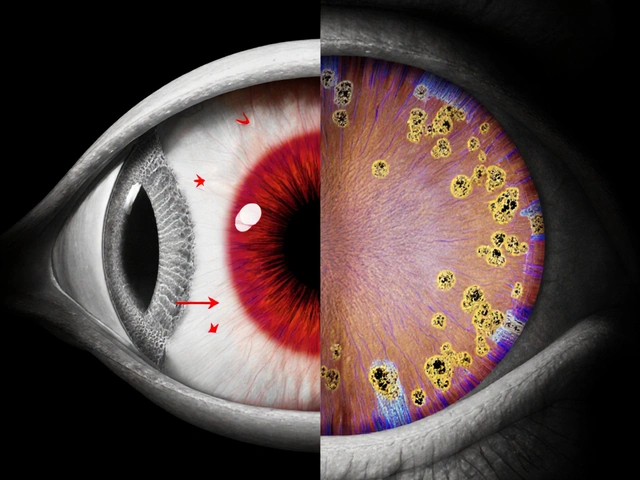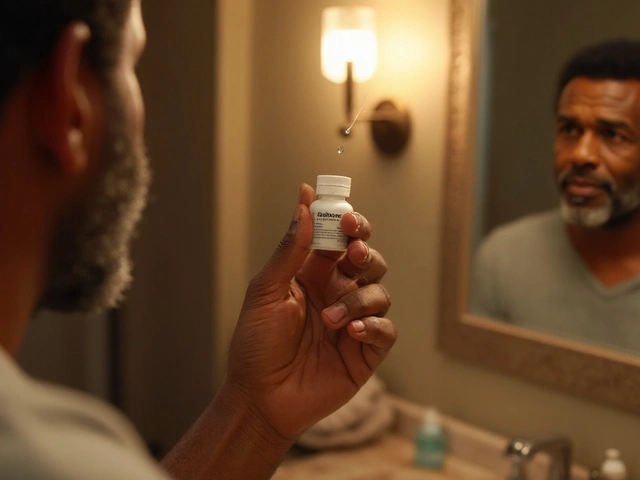Candidemia is a bloodstream infection caused by Candida species, often seen in critically ill patients and associated with high mortality. When the fungus spreads beyond the bloodstream, it becomes Disseminated candidiasis, involving organs such as the eyes, brain, and kidneys. Prompt candidemia treatment can mean the difference between recovery and a fatal outcome.
Why Candidemia and Disseminated Infections Demand Immediate Action
Critically ill adults in intensive care units (ICUs) have a 2-4% risk of developing candidemia, with mortality rates approaching 40% if therapy is delayed. The main drivers are central venous catheters, broad‑spectrum antibiotics, and impaired immunity. Once Candida invades deep organs, the clinical picture changes: visual loss from endophthalmitis, renal failure from microabscesses, or meningoencephalitis. Recognising these patterns early allows clinicians to start the right antifungal before organ damage becomes irreversible.
First‑Line Therapy: The Echinocandin Class
The 2023 IDSA (Infectious Diseases Society of America) recommendations place echinocandins as the preferred initial agents for most adult patients with candidemia. They inhibit β‑(1,3)‑D‑glucan synthesis, a cell‑wall component absent in human cells, which translates into excellent efficacy and a low toxicity profile. The three agents available in the UK are:
- Caspofungin - 70mg loading dose then 50mg daily.
- Micafungin - 100mg daily (adjust to 50mg in mild hepatic impairment).
- Anidulafungin - 200mg loading dose then 100mg daily (no dose adjustment needed for liver or kidney).
All three achieve high serum concentrations and penetrate most tissues, making them suitable for both candidemia and disseminated disease. Importantly, they retain activity against Candida auris, an emerging multidrug‑resistant pathogen that has been reported in several UK hospitals.
When Azoles Become the Better Choice
Azole agents, especially fluconazole, remain an option for patients who are clinically stable, have isolates susceptible on testing, and lack prior azole exposure. Fluconazole offers oral bioavailability >90%, allowing step‑down from IV to PO after 48-72hours of negative blood cultures. Typical dosing is 800mg loading, then 400mg daily; higher doses (12mg/kg) may be needed for deep‑tissue infection.
For infections caused by fluconazole‑resistant species (e.g., C. glabrata with dose‑dependent susceptibility or C. krusei), a broader azole such as voriconazole or posaconazole can be considered, but therapeutic drug monitoring is essential because of variable serum levels.
Polyenes: The Old Guard for Severe Cases
When a patient cannot tolerate echinocandins or the organism shows high‑level resistance, amphotericin B (conventional or liposomal) remains a life‑saving option. Liposomal amphotericin B (3-5mg/kg daily) reduces nephrotoxicity compared with the deoxycholate formulation (0.7‑1mg/kg). The drug’s broad spectrum covers virtually all Candida spp., and it achieves excellent fungicidal activity in the bloodstream and deep tissues.
The major drawback is renal impairment, especially in patients already on nephrotoxic meds. Electrolyte monitoring (potassium, magnesium) is mandatory, and dose reductions are advised when serum creatinine rises >2mg/dL.
Combination Therapy and Adjuncts
Evidence for routine combination therapy (e.g., echinocandin+flucytosine) is limited, but it may be justified in end‑organ involvement such as endophthalmitis, where high intra‑ocular concentrations are needed. Flucytosine penetrates the eye and CNS well; dosing is 25mg/kg every 6hours, adjusted for renal function. Close monitoring for bone‑marrow suppression is required.
For patients with central venous catheters, prompt removal is a core component of management. Studies show a 30% reduction in mortality when the catheter is removed within 24hours of diagnosis.

Duration, Monitoring, and De‑escalation
Standard therapy lasts 14days after the first negative blood culture and resolution of signs of infection. In disseminated disease, the duration may extend to 4-6weeks, guided by organ‑specific response (e.g., repeat ophthalmologic exams for endophthalmitis).
Therapeutic drug monitoring is most critical for azoles and flucytosine. Serum trough levels of fluconazole should exceed 4µg/mL; voriconazole troughs target 1‑5µg/mL. Echinocandin levels are not routinely measured but can be checked in patients with severe hepatic impairment.
Practical Decision‑Tree for Choosing Therapy
| Agent | Class | Typical Dose | Key Advantages | Major Toxicities |
|---|---|---|---|---|
| Caspofungin | Echinocandin | 70mg IV loading, then 50mg daily | Broad Candida coverage, low renal impact | Hepatic enzymes ↑, infusion reactions |
| Micafungin | Echinocandin | 100mg IV daily | No dose adjustment for kidney | Mild hepatic ↑, rare hypersensitivity |
| Anidulafungin | Echinocandin | 200mg IV loading, then 100mg daily | Stable pharmacokinetics, no hepatic dose change | Minimal, occasional rash |
| Fluconazole | Azole | 800mg IV/PO loading, then 400mg daily | Oral step‑down, excellent CSF penetration | Hepatotoxicity, QT prolongation |
| Liposomal Amphotericin B | Polyene | 3-5mg/kg IV daily | Broadest spectrum, fungicidal | Nephrotoxicity, electrolyte loss |
Emerging Resistance and Future Directions
Resistance to echinocandins has risen to ~5% in C. glabrata isolates, mainly due to mutations in the FKS genes. When an FKS mutation is identified, clinicians should switch to high‑dose fluconazole (if susceptible) or liposomal amphotericin B.
New agents such as ibrexafungerp (a glucan synthase inhibitor) and rezafungin (a long‑acting echinocandin) are in late‑stage trials and may offer once‑weekly dosing, an advantage for outpatient step‑down.
Related Concepts and Next Topics to Explore
Understanding antifungal susceptibility testing is vital for tailoring therapy. It bridges the gap between empirical choice and targeted treatment. Other closely linked areas include:
- Management of Candida endophthalmitis.
- Infection control measures for Candida auris outbreaks.
- Pharmacokinetic‑pharmacodynamic (PK‑PD) targets for echinocandins.
- Cost‑effectiveness analyses of oral step‑down strategies.
Readers interested in the broader landscape may next explore “Antifungal Stewardship in Critical Care” or “Guidelines for Managing Invasive Fungal Infections in Immunocompromised Hosts.”
Frequently Asked Questions
What is the fastest way to confirm candidemia?
Blood cultures remain the gold standard, but modern laboratories can deliver a positive signal within 24hours using automated detection systems. Adding a β‑D‑glucan assay improves early detection, especially in patients already on antifungal prophylaxis.
When should I switch from an echinocandin to fluconazole?
Switch is appropriate once the isolate is shown susceptible, the patient is clinically stable, and there are no contraindications such as hepatic failure or drug‑drug interactions. A typical timeline is after 48‑72hours of negative cultures and resolution of fever.
Is oral fluconazole as effective as IV therapy for deep‑tissue infection?
For most organ systems, high‑dose oral fluconazole achieves serum levels comparable to IV dosing due to >90% bioavailability. However, for central nervous system or ocular infections, initial IV therapy is recommended until CSF or ocular fluid levels are verified.
How do I manage a patient with Candida auris infection?
C. auris is often resistant to fluconazole and sometimes to echinocandins. Start with an echinocandin (if susceptibility is unknown) and obtain susceptibility results quickly. Infection control measures-contact precautions, dedicated equipment, and environmental cleaning with chlorine‑based products-are essential to prevent spread.
What are the key side effects to watch for with amphotericin B?
Nephrotoxicity is the most common; monitor creatinine daily. Electrolyte disturbances (hypokalemia, hypomagnesemia) occur in up to 30% of patients. Infusion‑related fever and chills are also frequent; pre‑medicating with acetaminophen or antihistamines can help.
When is combination therapy indicated?
Combination (e.g., echinocandin+flucytosine) is reserved for infections where monotherapy fails to achieve adequate tissue levels, such as endophthalmitis, CNS disease, or when the organism shows multidrug resistance. The decision should be guided by susceptibility data and specialist input.






12 Comments
Just had a patient on micafungin for 3 weeks - no kidney issues, no fuss. Seriously, these echinocandins are game changers. My ICU team switched entirely to them last year and we’ve seen a drop in readmissions.
wait so anidulafungin doesnt need dose adjust for liver?? i thought all of em did??
FLUCONAZOLE FOR THE WIN 💪🏽✨ i’ve seen patients go from ICU to home on oral fluconazole in 5 days. Stop overtreating with IV crap.
Oh sweetie, you’re still using amphotericin B? 😅 I mean, it’s like using a horse-drawn carriage when we have Teslas now. Liposomal is the only choice for anyone who wants to keep their kidneys intact. And if you’re not doing TDM on voriconazole… well, I just don’t know what to say.
Why are we even talking about fluconazole for candidemia? It’s 2025. If it’s not an echinocandin, you’re doing it wrong. I’ve seen so many residents get burned by waiting for susceptibilities - don’t be that guy.
Let me tell you something about FKS mutations - they’re not just a lab curiosity, they’re the new reality in ICUs. We had a cluster in Mumbai last year, all resistant to caspofungin, and guess what? The only thing that worked was high-dose anidulafungin + flucytosine combo. And yes, we had to monitor CBC every 48 hours because flucytosine turns your marrow into a ghost town. Also, Candida auris is not just a bug - it’s a geopolitical nightmare. Hospitals in Delhi are still using bleach wipes because they can’t afford UV robots. The global disparity in antifungal access is criminal.
Just wanted to say thank you for this. As someone who works in rural ERs with no ID consults, this breakdown saved my butt last month. I had a guy with endophthalmitis and no culture results yet - went with echinocandin + flucytosine based on your table. He’s seeing light again. You’re a legend.
YOU GOT THIS! 🙌🏽 One patient at a time. Keep pushing for early catheter removal - it’s the silent killer. And if you’re on the fence about switching to oral fluconazole? DO IT. Your patient will thank you when they’re eating pizza on the porch instead of stuck in a hospital gown. #AntifungalWarrior
It’s fascinating how the pharmacokinetics of echinocandins remain stable despite hepatic impairment - almost poetic, really. The body’s resilience, paired with modern science, creates a quiet triumph. One wonders, though, whether we’re over-relying on mechanistic certainty and underestimating the chaos of clinical reality. Perhaps the real hero isn’t the drug, but the nurse who notices the subtle drop in urine output before the creatinine spikes.
Thank you for the comprehensive overview. I would like to note that therapeutic drug monitoring for voriconazole should ideally be performed at steady state, typically after five doses. Additionally, the 2024 update to the IDSA guidelines now recommends considering rezafungin for patients requiring extended outpatient therapy, pending formulary approval.
America’s healthcare system is broken but at least our antifungals are top-tier. You think Europe’s got this? Nah. They’re still using fluconazole like it’s 2008. We’ve got liposomal amphotericin, echinocandins, and now rezafungin coming - we lead the world. Stop comparing us to countries that can’t even afford a basic blood culture.
Regarding the use of flucytosine: the therapeutic window is narrow, and the risk of myelosuppression is non-trivial. In my practice, I require baseline and weekly CBCs, and I avoid concurrent use with zidovudine or trimethoprim-sulfamethoxazole. The literature supports its utility in endophthalmitis, but only when susceptibility is confirmed and specialist consultation is obtained.